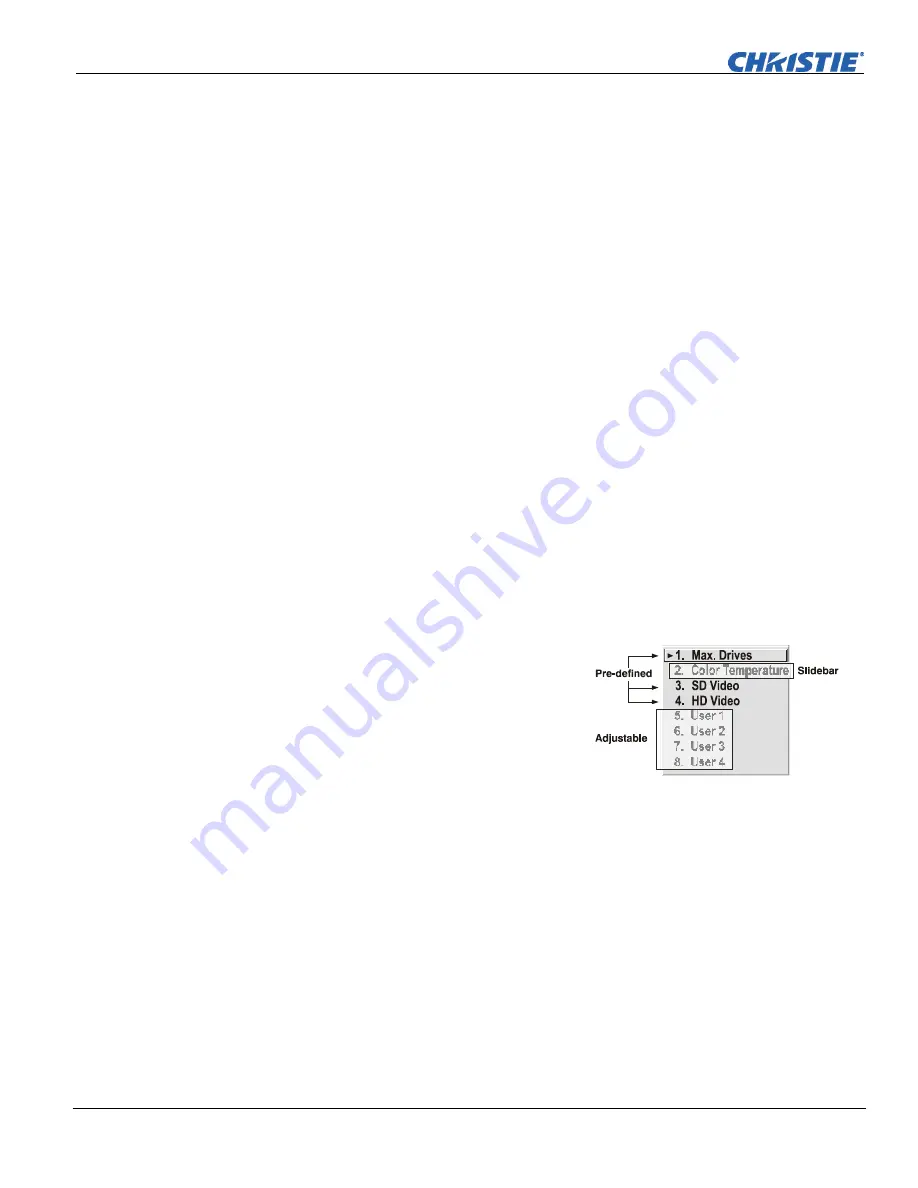
Section 3: Operation
3-46
Mirage S+/HD, Matrix S+/HD, Christie HD/DS/DW, DLV User’s Manual
020-100001-04 Rev. 1 (12/07)
- Software v1.6g or higher
NOTES:
1)
See also
3.10,
Using Multiple Projectors
for the complete step-by-step
procedure for achieving uniform brightness in adjacent displays.
2)
If Christie TWIST
module is installed, the enable checkbox changes to a list giving the option to choose
from several different uniformity maps. Please refer to documentation included with
your Christie TWIST module.
Edge Blending
— SUBMENU
The
Edge Blending
submenu provides a range of controls for smoothing together the
overlapping bright edges of multiple adjacent projected images to create a single
larger “seamless” image. These controls, which primarily affect white levels, are
typically used in conjunction with mechanical lens blinders (optional), which are
installed on the front of the projector and which primarily affect black levels. There is
a centerline (both horizontal and vertical) in the Edge Blending test pattern. The
intersection of these lines is the true center of the projector’s display area.
NOTES: 1)
There is a centerline (both horizontal and vertical) in the Edge Blending
test pattern. The intersection of these lines is the true center of the projector’s display
area.
2)
See also
3.10,
Using Multiple Projectors
.
Color Adjustments by X/Y, and Color Saturation —
SUBMENUS
NOTES:
1)
For defining or changing a User 1, 2, 3, or 4 color performance or
“gamut”. Sometimes known as Comprehensive Color Adjustment™.
2)
Factory-
defined primary color levels, which ensure a specific color performance from
projector-to-projector, can be calibrated in the
Service
menu only. If you suspect
alteration of these defaults, the factory settings can be recovered with selection of
“
Reset to Factory Defaults?
”
in the
Color Primary Settings
submenu accessed via
the
Service
menu (password-protected).
From the factory, the projector can utilize
any of the three pre-defined color
performance settings identified at right
(default=Max Drives), or colors can be
driven on the basis of color temperature.
For most applications, one of these gamuts
will produce accurate and realistic colors
from a variety of sources. They can be
applied at any time in the
Advanced Image
Settings
menu (“Select Color
Adjustment”), and are not adjustable.
DEFINING “USER” COLOR GAMUTS:
In some cases, you may find that none of the pre-
defined “Select Color Adjustment” options exactly suit your needs. For example, you
may require a unique color gamut (range) for a single projector or application, or you
may need to precisely match colors across multiple adjacent displays. In such cases,
use the
Color Adjustments by X,Y
or
Color Saturation
submenu to define the precise
hue
of each primary color component (red, green, blue, and white) used to generate
the millions of colors produced in displays. You can create up to four custom color
gamuts (User 1, 2, 3, or 4) with these adjustments.
Note that the two menus differ only in their user interface, so use whichever menu
best suits your needs and application. A color meter can help with adjustments.






























